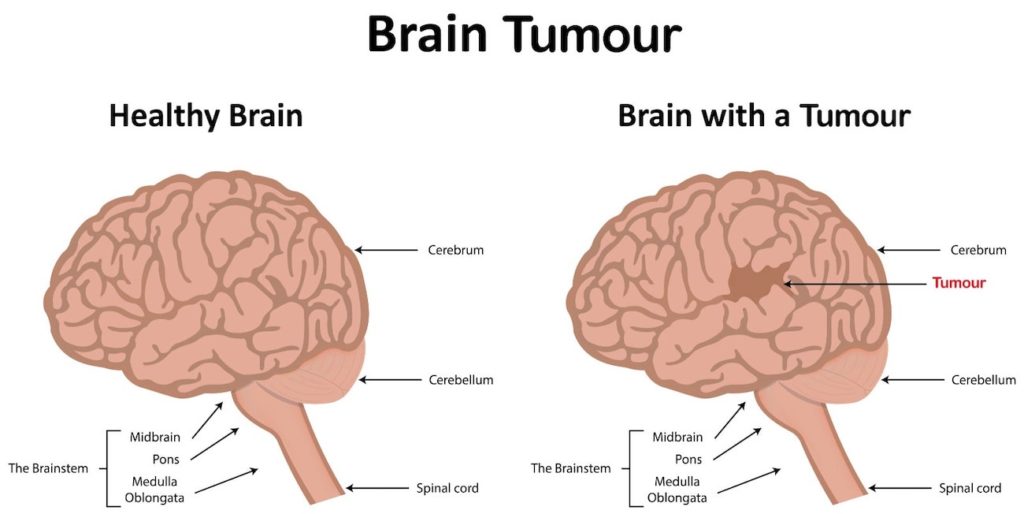Has this article been insightful? Share it!
A brain tumour, also known as an intracranial tumour, is an abnormal mass of cells in the brain that can either be cancerous (malignant) or non-cancerous (benign). Both types of tumours grow in size within a confined rigid skull box and build up the pressure inside the skull.
If left untreated, this increased pressure can cause life-threatening brain damage. The growth rate of a brain tumour varies widely, and is entirely based on the underlying tumour type. The severity and clinical presentations of brain tumours depend on the tumour location, size and type of tumour.
There are two main types of brain tumours — primary and secondary brain tumours.
The tumour arising from any brain tissue, or its membrane, or nerve fibres are known as primary brain tumours. The rate of growth varies significantly depending on the type of primary tissue. Some tumours are aggressive and fast-growing, while others grow relatively slower. Gliomas, the most common type of primary brain tumour, are particularly concerning due to their aggressive nature and tendency to spread within the brain’s parenchyma, often resulting in a poor prognosis.
Secondary brain tumours, or metastatic tumours, arise when cancer cells from other parts of the body spread to the brain via the bloodstream. Not all cancers can metastasize to the brain, but the most common types include breast, lung, skin, and colon cancers.
The exact cause of brain tumours is still unknown. However, one hypothesis suggests that mutations in a cell’s DNA may trigger these tumours. These mutations cause the cells to grow and divide uncontrollably. As a result, the abnormal tumour cells form a mass that disrupts the normal tissue, drawing away blood supply from healthy cells and weakening the immune system.
The rapid growth of abnormal tumour cells causes a mass effect, pushing against and compressing healthy brain cells. This compression can lead to inflammation, damage to nearby cells, and swelling in the brain. As pressure builds up inside the brain, it can ultimately lead to severe complications and, in some cases, be fatal.

The well-known risk factor is radiation exposure to the brain. Other risk factors are:
There are no exact risk factors that relate brain tumours to certain types of food and the use of handheld devices, such as handphones.
The most typical symptoms of brain tumours are headaches, and feelings of nausea or vomiting in the early morning. Some specific symptoms are experienced in relation to the location and size of the tumour in the brain which may include:
If you are experiencing such unexplained symptoms, you should see a doctor. Your doctor can evaluate your symptoms and make an appropriate referral to a Singapore neurosurgeon for further evaluation and investigations to rule out brain tumours. An early diagnosis is important for the management of brain tumours.
During your first consultation for brain tumours, a neurosurgeon will begin by discussing your symptoms in detail, along with your personal and family medical history. This helps the doctor understand your condition better.
Next, a thorough neurological examination will be performed to assess your current health. Based on these findings, your doctor may order additional tests, such as MRI or CT brain scans, to either confirm or rule out potential causes.
Subsequently, the doctor will explain these findings and investigations, the discuss possible brain tumour treatment options with you. Rest assured, your doctor will work with you to develop a treatment plan best suited to your condition.
Diagnosing a brain tumour involves several key steps, beginning with a detailed patient history and physical examination. These initial assessments help identify symptoms and potential risk factors.
To confirm the diagnosis, imaging studies and histological examinations (analysis of tissue samples) are essential. Here are some common imaging studies used:
A basic imaging study which is used to diagnose a brain tumour. A gadolinium-based dye or contrast is administered via IV for the test, enhancing and improving the clarity of the MRI scans.
When a standard MRI scan fails to provide a clear diagnosis, this technique is utilised. It helps differentiate between brain lesions and can be useful for excluding effects from radiation or infection.
A functional MRI is a more sophisticated imaging study done before an operation that helps clarify the location of the tumour relative to important functional areas in the brain.
Primarily used for follow-up after treatment, allowing doctors to monitor changes in the tumour and assess treatment effectiveness.
A navigation scan used to help the surgeon during an operation. The scan provides the neurosurgeon with the exact location of the tumour and the important structures that surround it.
Both imaging tests are important in assessing the blood supply and the relationship of the tumour to major blood vessels and venous sinuses in the brain.
A PET scan is very useful for studying the metabolic activity of tumours and surrounding healthy cells in the body. It helps identify actively growing tumour cells and is often used to monitor the tumour after treatment.
Brain tumours can often be treated successfully thanks to improvements in techniques, technology, and imaging. However, this ultimately depends on a variety of factors such as the type and grade of the tumour, its size and location, and other medical conditions the patient may have.
Most benign brain tumours can be successfully treated with brain tumour surgery, radiation or medication like chemotherapy. Some malignant brain tumours can be well controlled with a combination of modern treatments, offering patients the chance to maintain a good quality of life.
Brain tumours can be treated in 3 main ways: Surgery, Radiation and Chemotherapy.
Surgery is a mainstay in the treatment and diagnosis of brain tumours. Traditionally, open surgery is performed to evacuate the brain tumour. However, technological developments have helped the current neurosurgical practice diagnose and treat tumours via keyhole / minimally invasive approaches.
A minimally invasive (keyhole) approach or endoscopic surgery is a less destructive alternative to open brain surgery and has transformed how brain tumours are treated. It allows neurosurgeons to identify and treat conditions within the brain with reduced risk and faster recovery. It has become a standard approach in treating certain types of tumours, depending on the type and location.
Either single or fractionated radiotherapy can be used to effectively control certain types of brain tumours including benign brain tumours. Different types of radiation such as Gamma Rays or Proton Beams are available in Singapore for the treatment of brain tumours.
Chemotherapy for brain tumours involves medications that can be taken orally or administered through injections. The choice of medication and the treatment duration are determined by a specialist, typically a neuro-oncologist, based on the specific needs of the patient.
Nowadays, immunotherapy is available for certain types of tumours. This involves stimulating the body’s immune system to destroy the cancer cells. The treatment may be used in combination with other therapies, depending on the type and size of the tumour.
While getting diagnosed with a brain tumour can be scary, it is important to get diagnosed as early as possible to increase your chances of successful treatment. If you are experiencing any of the symptoms associated with brain tumours, please do not hesitate to see a doctor as soon as possible. Your doctor will be able to accurately diagnose your condition and find a brain tumour treatment method that is best suited to your needs.
For care and support, the Advanced Brain and Spine Surgical Centre is here to help. Our team offers comprehensive diagnostic and treatment options, along with resources to help you manage your condition. Contact us today to schedule a consultation and learn more about how we can support you through this journey.

Senior Consultant
Neuro & Spine Surgeon
MBBS, MSc Surgery, MRCS (Edin),
MMed. Sc (Gen Surg) (S'pore),
FRCS. Surgical Neurology (UK)
Dr Sein Lwin is an experienced Senior Consultant Neuro & Spine Surgeon and the Neurosurgical Director at the Advanced Brain and Spine Surgical Centre.
He is highly experienced in spine surgery and in minimally invasive approaches for spinal cord tumours and degenerative spine surgery. His specialised interests lie in endoscopic endonasal and open skull base surgery, pituitary tumours, vascular surgery, cranial nerve disorders and peripheral nerve conditions.
Many neurological conditions may require urgent attention. If you require immediate care, please contact us.
Contact Us For More Information
We provide quality specialised care for neuro and spine conditions.
For enquiries, leave a message and our friendly team will get in touch with you.
Monday – Friday: 9:00AM – 5:00PM
Saturday: 9:00AM – 12:30PM
Sunday & Public Holiday: Closed
We provide quality specialised care for neuro and spine conditions.
For enquiries, leave a message and our friendly team will get in touch with you.
Monday – Friday: 9:00AM – 5:00PM
Saturday: 9:00AM – 12:30PM
Sunday & Public Holiday: Closed
We provide quality specialised care for neuro and spine conditions.
For enquiries, leave a message and our friendly team will get in
touch with you.
Monday – Friday: 9AM – 1PM | 2PM – 5PM
Weekends & Public Holidays: CLOSED
© 2023 All Rights Reserved | Advanced Brain & Spine Surgical Centre | Terms & Conditions